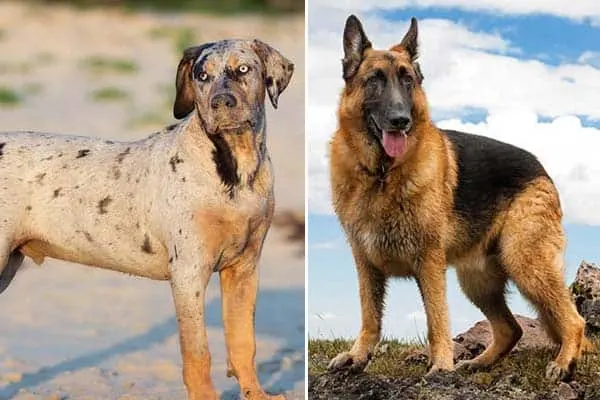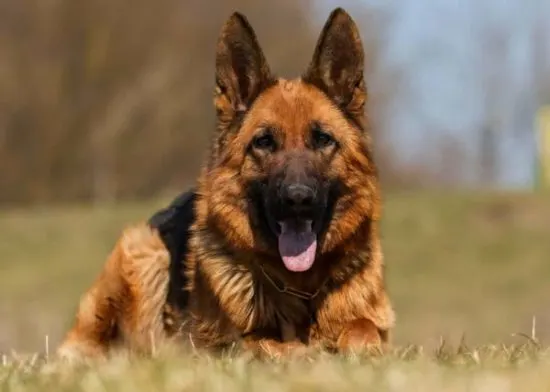Catahoula German Shepherd Mix: What a Working Dog This Is
If you’re looking for a working dog that is laser-focused yet enjoys being a companion too, look no further than the Catahoula-German Shepherd mix.
This dog may appear as a little aloof, but that is because his primary goal in life is to work.
This hybrid breed is territorial and tends to be leery of strangers. In fact, when with his handlers, the Catahoula-German Shepherd mix will exhibit guarding tendencies.
The Catahoula-German Shepherd Mix is not for novice owners. This designer dog does best when interacting with experienced owners.

Catahoula German Shepherd Mix: Meet The Catahoula Parent Breed
According to AKC, The Catahoula Cur (sometimes referred to as the Louisiana Catahoula Leopard dog) is a dog that is itself a mixture of many outstanding breeds. Likely, the Catahoula is descended from a mix of Greyhounds, Bloodhounds, Mastiffs, and possibly wolves.
The Catahoula typically has a mottled coat that might be black, blue, brindle, chocolate, tan, red, yellow, with splotches of white mixed in.
This coat will be short and coarse when observed, many states that the Catahoula appears to trot like a horse. Some Catahoula dogs may have pale blue eyes, referred to as “glass” eyes.
Others may have what is called “cracked” eye coloring, which means each eye has a different color (for instance, one may be green and the other amber or brown).
Size
Catahoula dogs are fairly large. They typically weigh between fifty and ninety pounds. They are muscular and tenacious dogs, usually bred for hunting and herding.
They are used for flushing out feral hogs across the southern United States, and they are known to be fearless against this particularly dangerous animal.
The Catahoula is not a dog that owners should expect to be happy spending a great deal of time in a kennel or confined to one corner of the yard. To be certain, if a Catahoula is left to its own devices, he will become destructive.
By destructive, this means that the Catahoula may dig holes in your yard, chew on various items, or otherwise damage your belongings.
This problem is easy to solve if you keep the Catahoula busy! This dog was developed to work, and a tired Catahoula is a happy Catahoula! They enjoy herding and guarding.
Their guarding instinct often makes them appear reserved around those they do not see around their family on a regular basis.
Growth Stages
Owners should also keep in mind that the Catahoula develops both physical and mental maturity later than other dog breeds.
They are not fully physically grown until they are at least two years of age, and they may behave like a puppy (playful, energetic, impulsive) for another year or so.
Again, keep in mind that providing the Catahoula with lots of exercises will help to prevent boredom and mischief.
The Catahoula is often mixed with any number of other breeds. One such great combination is the German Shepherd. Find out why these two dog breeds are highly compatible.
Our YouTube Video On The Catahoula German Shepherd
The German Shepherd Parent Breed
The German Shepherd is a dog with origins in Northern Europe. It is believed that, like the Catahoula, the German is also descended from wolves.
However, no one can say exactly what breeds were utilized to develop the German Shepherd or GSD as we know the breed today.
We do know that the modern German Shepherd dog was first whelped in 1899 after much work by enthusiast Captain Max Von Stephanitz, who was a retired military officer.
Von Stephanitz had always admired the various shepherd herding dogs used throughout the German countryside, but he wished to see these dogs developed into one superior breed.
Breed History
In order to develop the various shepherding dogs into the ultimate dog, Von Stephanitz studied dog breeding in Great Britain. He would borrow many of their techniques and apply them to his development of the GSD.
He also observed a number of dog breeds similar to those in Germany shepherding communities. In 1899, he purchased a show dog named Hektor Linksrhein. Hektor was a well-bred dog, strong and highly intelligent.
According to Total-German-Shepherd, declare Hektor (then renamed Horand von Grafrath) the first German Shepherd dog, and the Captain created the Verein fur Deutsche Scharferhunde (or, the Society for the German Shepherd Dog).
Horand was then paired with other similar dogs deemed of high quality for breeding, and a certain pup, Hektor von Schwaben, was chosen to be bred with other dogs to promote the traits deemed most important for the GSD.
Eventually, these dogs would be bred back to other offspring of Horand’s, and genetic records show that there were at least four wolf-crosses used as a part of Von Stephanitz’s breeding program.
Effects of the First World War
Between 1899 and the first World War, the German Shepherd dog had grown in popularity. However, the original purpose of the GSD was about to change.
As industrialization slowly progressed through Europe, many farmers left their original occupations for work in factories.
Von Stephanitz would not be outdone, however. He knew that the military needed dogs that were intelligent and highly trainable as well as courageous.
Of course, his beloved German Shepherds were perfectly suited to such a task. Von Stephanitz began to train dogs for this purpose and market the breed for police and military work.
During World War I, the German Shepherd dog was utilized by the Red Cross as a rescue and medical dog. The German Army used the dog as a messenger, supply carrier, and rescue dog as well.
Excellent Working & Protection Dogs
The German Shepherd dog also served as a sentry, or guard dog. Even today, the German Shepherd dog is well-suited to this task.
Even though the GSD was a dog utilized by the European enemy, many Allied servicemen noted the intelligence and bravery of the breed. This is how the German Shepherd made its way to the United States.
Although we do not know the exact number and what GSDs came to America this way, we do know the history of one highly notable German Shepherd.
An American soldier patrolling a bomb-riddled city in France happened upon a five-day-old German Shepherd puppy.
He rescued the pup, took him home to Los Angeles, and began training the dog for Hollywood. The German Shepherd known as Rin Tin Tin started life in a very frightening way, but he became the face of the breed in America.
Amazingly enough, the German Shepherd dog garnered a negative reputation due to its German roots. Not only did Americans fight against this European enemy in World War I, but Hitler himself owned a German Shepherd.
Prinz, as Hitler called him, had to be rehomed when the Further was younger and destitute. However, Prinz escaped from his new home and returned to his original owner.
Due to the negative connotation many associated with the breed, the American Kennel Club renamed the dog “the Shepherd Dog,” and in the United Kingdom, the breed was known for many years as the Alsatian Wolf Dog.
Breeding Programs
Developer Von Stephanitz closely monitored breeding programs, and he was dismayed to find that the breed began to exhibit some negative traits, such as a bad temperament and issues with dental health.
The Captain stepped in to correct the issue. He instituted a practice by which any dog that was to be a part of a breeding program must pass certain health and temperament tests.
As a result, the German Shepherd breed improved. Although some American breeders had not adhered to Von Stephanitz’s directives, once European and American GSDs began to breed, the German Shepherd dogs improved dramatically in both health and temperament.
Today, the German Shepherd remains a loyal working dog. Some may work as service dogs for the blind or those with PTSD (German Shepherds have had a tremendous impact on treating this condition).
Other GSDs work as police dogs; others have been trained to sniff out bombs as military dogs. Working is the specialty of the German Shepherd, and they are happiest serving others.
The Catahoula German Shepherd Mix
Does the Catahoula (or Louisiana Catahoula Leopard dog) breed mix well with the German Shepherd dog? The answer is a resounding yes!
The two breeds tend to be very much alike in temperament. They both love to work, and they enjoy similar working tasks.
Both the Catahoula and the German Shepherd dog are a little leery of strangers. This is due to their desire to guard their family and places they deem to be a part of their “territory” (read – family property).
However, once acquainted with non-family members who are frequent visitors, they will accept strangers and possibly protect them too.
A Catahoula and German Shepherd mixed dog is also highly likely to exhibit herding instincts. You may notice the dog “herding” small children, which can be somewhat upsetting to parents. However, this is the breed protecting even the littlest of its human family.
One cannot deny the desire of the Catahoula parent breed to hunt and pin down prey. Coupled with the herding instinct of both parent breeds, the Catahoula/German Shepherd dog mix makes an excellent hunting companion as well.
See a Catahoula German Shepherd Mix in action in this video!































